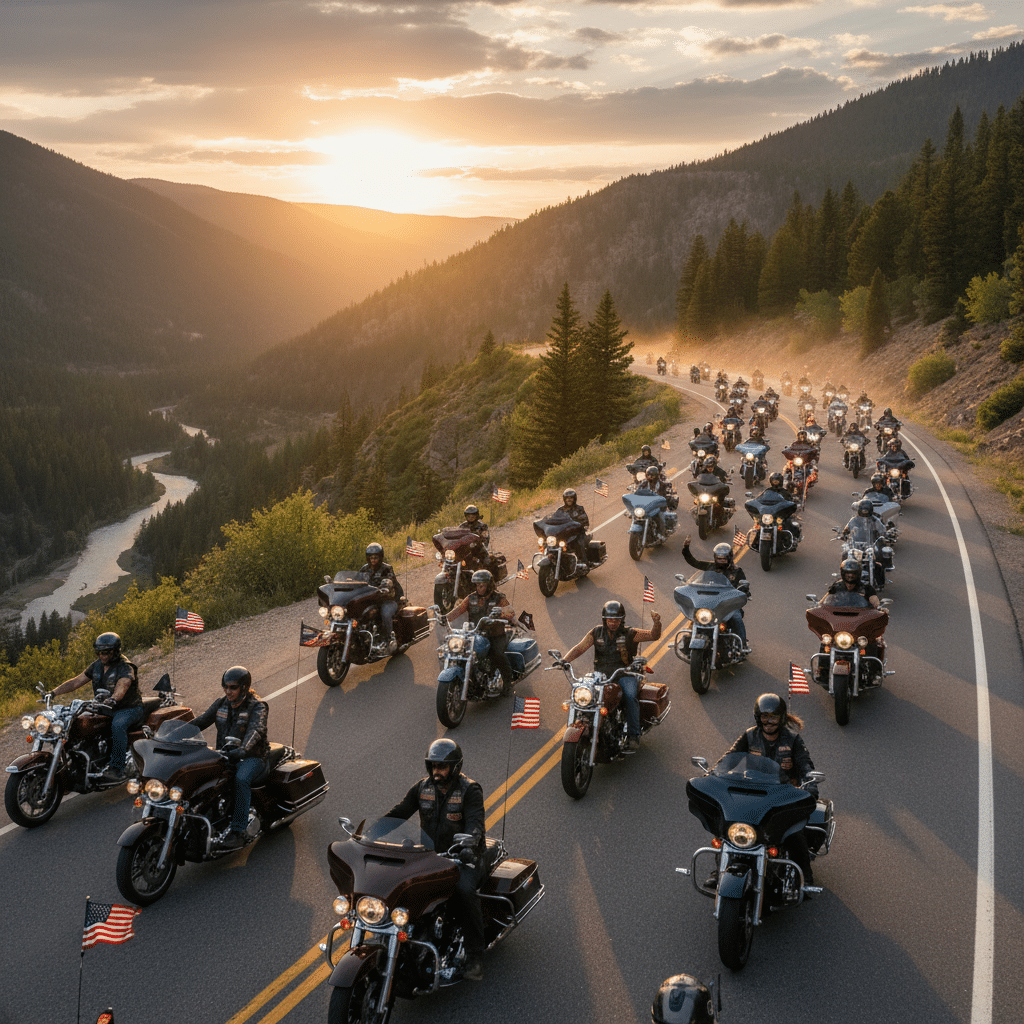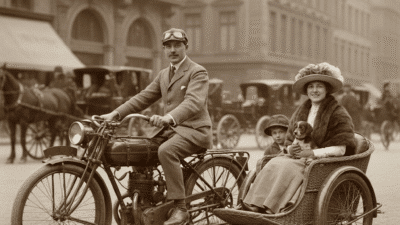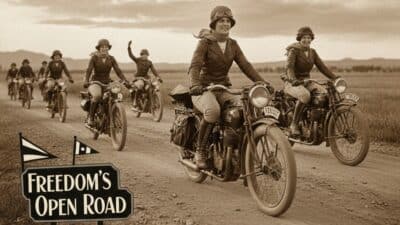Harley-Davidson. The very name conjures images of freedom, open roads, and an undeniable roar that resonates deep within the soul. For generations, this iconic American brand has stood as a symbol of rebellion, craftsmanship, and a distinctly American spirit. Yet, beneath the gleaming chrome and powerful engines lies a dramatic tale of survival, a gripping narrative of Harley-Davidson’s near bankruptcy and comeback that saw the legendary company teeter on the brink of oblivion before orchestrating one of the most remarkable corporate turnarounds in history. This isn’t just a story about motorcycles; it’s a testament to resilience, passion, and the unwavering loyalty of a dedicated community.
Imagine a world where the thrum of a V-twin engine was silenced forever. It’s a terrifying thought for any enthusiast. But in the late 1970s and early 1980s, this grim reality was perilously close for the Motor Company. Beset by quality issues, fierce competition, and a loss of identity, Harley-Davidson faced financial ruin. How did a brand so deeply embedded in American culture find itself in such a predicament? More importantly, how did it claw its way back to not just survive, but thrive, becoming stronger and more revered than ever before? Buckle up, because we’re about to ride through an epic saga of triumph over adversity.
The Roaring Twenties and the War Effort: Early Glory and Growing Pains
From its humble beginnings in a Milwaukee shed in 1903, Harley-Davidson quickly established itself as a pioneer in the burgeoning motorcycle industry. William S. Harley and the Davidson brothers, Arthur, Walter, and William, built their first production motorcycle with a single-cylinder engine, setting the stage for a century of innovation and cultural impact. By the 1920s, Harley-Davidson was the largest motorcycle manufacturer in the world, renowned for its sturdy, reliable machines and its dominance in racing. The company’s distinctive V-twin engine, introduced in 1909, became its signature, delivering the torque and sound that enthusiasts craved.
The brand’s robust machines proved indispensable during both World War I and World War II. Thousands of Harley-Davidson motorcycles, like the iconic WLA, served vital roles on battlefields around the globe, cementing their reputation for durability under the harshest conditions. This period also saw the incredible evolution of early motorcycle engines, constantly pushing the boundaries of power and reliability. After the wars, returning veterans often sought out the very bikes they had ridden in combat, further fueling Harley’s mystique and solidifying its place in American culture.
However, even with this impressive foundation, challenges loomed. The post-war economic boom brought fierce competition, especially from European brands, and later, the seismic shift with the arrival of highly efficient, often more affordable, Japanese motorcycles. Harley-Davidson, perhaps resting on its laurels a little too long, was about to face its toughest test.
The AMF Era: A Recipe for Disaster
The turning point that led Harley-Davidson to the precipice of bankruptcy began in 1969, when the company was acquired by American Machine and Foundry (AMF), a conglomerate best known for bowling equipment. The intention was to inject much-needed capital and streamline production, but the reality proved to be disastrous.
AMF’s ownership brought a focus on mass production, aiming to increase output significantly. While this sounds good on paper, it came at a tremendous cost: quality. To meet production quotas, corners were cut. Components became less reliable, fit and finish suffered, and the legendary durability of a Harley-Davidson began to erode. Owners experienced frequent breakdowns, oil leaks became commonplace, and the overall craftsmanship plummeted. Dealers struggled with an influx of warranty claims, and customer satisfaction plummeted.
This period was characterized by a painful disconnect. Enthusiasts who valued the brand’s heritage and engineering felt betrayed. The very essence of what made a Harley-Davidson special—its rugged individuality, its meticulous build quality—was being sacrificed on the altar of corporate efficiency. The motorcycles produced during this era earned the derisive nickname “AMF Harleys,” and the brand’s reputation was severely tarnished. Sales declined, market share dwindled, and the loyal customer base began to look elsewhere, primarily to the rapidly improving and innovative Japanese manufacturers like Honda, Yamaha, Kawasaki, and Suzuki, who offered technologically advanced, reliable, and often cheaper alternatives.
By the early 1980s, Harley-Davidson was in dire straits. The company was losing money, its products were a shadow of their former glory, and bankruptcy seemed inevitable. The roar was fading.

The Daring Buyout: Taking Back the Reigns
Against this bleak backdrop, a glimmer of hope emerged. In 1981, a group of 13 senior Harley-Davidson executives, led by Vaughn Beals and Willie G. Davidson (grandson of one of the founders), decided to do the unthinkable: they launched a leveraged buyout to purchase the company back from AMF. It was a monumental risk, requiring immense personal sacrifice and belief in the brand. They secured a loan of $80 million, effectively betting their careers, homes, and futures on the revival of the Motor Company.
This was not merely a financial transaction; it was a reclamation of identity. The executives understood that Harley-Davidson was more than just a product; it was a lifestyle, a community, a piece of Americana. They knew they had to reconnect with the core values that had built the brand. This daring move marked the true beginning of Harley-Davidson’s epic comeback.
Pros and Cons
| Pros | Cons |
|---|---|
| – Reclaimed brand identity and control | – Enormous debt burden from buyout |
| – Renewed focus on quality and heritage | – Lingering poor reputation and customer distrust |
| – Energized workforce with shared ownership | – Intense competition from Japanese manufacturers |
| – Ability to make swift strategic decisions | – Outdated manufacturing processes and technology |
The Road to Recovery: A Multifaceted Strategy
The executives knew that reclaiming Harley-Davidson’s legacy would require more than just passion; it demanded a ruthless focus on quality, strategic innovation, and a deep understanding of their customer base. They implemented a series of bold initiatives that would systematically rebuild the company from the ground up.
Quality as the North Star: Embracing SPC
The first and most critical step was to address the abysmal quality issues. The new leadership implemented Statistical Process Control (SPC), a revolutionary manufacturing philosophy popularized by Japanese automakers. This involved empowering workers on the factory floor to identify and solve problems, ensuring quality was built into every step of the production process rather than being inspected at the end. It was a dramatic shift from AMF’s quantity-over-quality approach.
- Employee Empowerment: Workers were given the tools and training to monitor production, suggest improvements, and stop the line if a defect was found. This fostered a sense of ownership and accountability.
- Supplier Relationships: Harley-Davidson worked closely with its suppliers, insisting on higher quality components and building collaborative relationships rather than purely transactional ones.
- Design for Manufacturability: Engineers began designing parts and assemblies with ease of manufacturing and quality control in mind, reducing potential points of failure.
This relentless pursuit of quality wasn’t an overnight fix. It took years, but slowly and surely, the reliability of Harley-Davidson motorcycles began to improve, winning back the trust of skeptical riders.

The Power of Patriotism and Tariffs
In a stroke of strategic genius and perhaps a bit of luck, Harley-Davidson also leveraged protectionist trade policies. In 1983, the company successfully petitioned the U.S. International Trade Commission (ITC) for temporary tariffs on imported Japanese motorcycles with engine displacements over 700cc. Harley argued that years of aggressive pricing by Japanese competitors constituted unfair trade practices and threatened the very existence of the last American motorcycle manufacturer.
President Reagan approved the tariffs, providing Harley-Davidson with crucial breathing room to implement its quality improvements and retool its factories without being completely overwhelmed by foreign competition. While controversial, these tariffs are widely credited with giving the company a vital lifeline during its most vulnerable period. It also tapped into a powerful wave of American patriotism, with many riders choosing Harley-Davidson to “buy American.” This was a significant factor, much like how many historical automotive patents that changed everything were born from national pride and economic necessity.
Reconnecting with the Rider: The H.O.G. Factor
Perhaps Harley-Davidson’s most brilliant move was to embrace and cultivate its unique culture. In 1983, the company officially launched the Harley Owners Group (H.O.G.). This wasn’t just a marketing ploy; it was a recognition and celebration of the passionate community that had always been at the heart of the brand.
H.O.G. offered members benefits like roadside assistance, rallies, discounts, and most importantly, a sense of belonging. It transformed motorcycle ownership from a solitary pursuit into a shared experience, creating a powerful, self-sustaining ecosystem of brand loyalty. H.O.G. chapters formed worldwide, organizing rides, events, and charity work. This created an unparalleled brand ambassador network. The distinctive “potato-potato” rumble of a Harley engine became the soundtrack to a global brotherhood and sisterhood of riders.

Product Innovation and Adaptation: Balancing Tradition with Progress
While critics often accused Harley-Davidson of being resistant to change, the company did introduce significant innovations crucial to its comeback.
- The Evolution Engine (Blockhead): Introduced in 1984, the “Evo” engine was a complete redesign that addressed many of the reliability issues of previous engines. It was more durable, ran cooler, and was less prone to oil leaks, rebuilding confidence in Harley’s engineering.
- Softail Frame: This innovative frame design, which hid the rear suspension beneath the transmission, offered the classic rigid-frame look with the comfort of modern suspension. It was a prime example of blending tradition with practical improvement, showcasing how internal engineering can differentiate a product. For other examples of how brands innovate to stay ahead, consider the rebirth of brands that have found new life by adapting to market needs.
- Strategic Acquisition: In 1993, Harley-Davidson acquired Buell Motorcycle Company, a smaller, innovative manufacturer focused on sportier bikes. This allowed Harley to tap into different market segments and experiment with new technologies without alienating its traditional customer base.
These product developments, combined with a renewed focus on quality and a powerful brand community, laid the foundation for incredible growth throughout the late 1980s and 1990s. The waiting lists for new Harleys grew longer, and the company’s stock soared.
Modern Challenges and the Road Ahead
Harley-Davidson’s comeback was undeniably triumphant, but the journey didn’t end there. The automotive and motorcycle industries are constantly evolving, and the Motor Company faces new challenges in the 21st century.
- Aging Demographic: Harley’s traditional customer base is aging, and attracting younger riders has become a key strategic imperative. This requires offering different types of bikes and experiences.
- Environmental Concerns and Electric Vehicles: The shift towards sustainable transportation is undeniable. Harley-Davidson made a bold move by launching LiveWire, its all-electric motorcycle brand, demonstrating a commitment to future-proofing.
- Global Competition: New competitors constantly emerge, and existing ones continue to innovate. Harley must maintain its unique value proposition while staying relevant in a crowded market.
- Changing Rider Preferences: Many new riders are looking for lighter, more agile, and technologically advanced motorcycles. Harley has responded with models like the Pan America adventure tourer and the Bronx streetfighter concept, expanding beyond its cruiser heritage.
The company continues to diversify its offerings and explore new markets. From expanding its apparel and merchandise lines to investing in digital engagement and rider training programs, Harley-Davidson is actively working to ensure its legacy continues for another century. Their ability to adapt and maintain their unique identity while embracing new technologies like electric powertrains is critical. Much like how to check and replace the brake pads on your motorcycle is crucial for safety, continuous innovation is crucial for a company’s survival.

The Unbreakable Spirit of the Bar and Shield
The story of Harley-Davidson’s near bankruptcy and phenomenal comeback is more than just a business case study; it’s an inspiring narrative about the enduring power of a brand, the resilience of dedicated individuals, and the unwavering loyalty of a passionate community. From the brink of financial collapse, Harley-Davidson not only saved itself but redefined what it means to be an American icon.
The challenges were immense: corporate mismanagement, quality control nightmares, intense foreign competition, and a fractured identity. Yet, through decisive leadership, an unyielding commitment to quality, a brilliant community-building strategy with H.O.G., and strategic product evolution, Harley-Davidson roared back to life. It proved that sometimes, the heart of a brand is more powerful than any balance sheet.
Today, Harley-Davidson continues to navigate the complexities of a rapidly changing world, balancing its rich heritage with the demands of innovation. The rumble of a Harley engine remains a potent symbol of freedom, individuality, and the open road. It’s a testament to a company that refused to die, choosing instead to fight, adapt, and ride into the future with an unstoppable spirit. What an incredible ride it’s been, and what an exhilarating journey still lies ahead for this legendary Motor Company!

Frequently Asked Questions
What caused Harley-Davidson’s near bankruptcy in the early 1980s?
Harley-Davidson faced near bankruptcy primarily due to a decline in product quality and a tarnished reputation during its ownership by AMF (American Machine and Foundry) from 1969 to 1981. This, coupled with fierce competition from reliable and affordable Japanese motorcycles, led to significant financial losses and dwindling market share.
Who bought Harley-Davidson from AMF in 1981?
In 1981, a group of 13 senior Harley-Davidson executives, led by Vaughn Beals and Willie G. Davidson, orchestrated a leveraged buyout to purchase the company back from AMF. This daring move was a pivotal moment in the company’s comeback story.
How did Harley-Davidson improve its product quality after the buyout?
The new leadership implemented Statistical Process Control (SPC), empowering factory workers to monitor and improve quality at every stage of production. They also focused on rebuilding relationships with suppliers and designing for manufacturability, ensuring reliability was built into every component.
What is the Harley Owners Group (H.O.G.) and how did it contribute to the comeback?
The Harley Owners Group (H.O.G.) is an official, factory-sponsored club launched in 1983. It played a crucial role by fostering a strong sense of community and loyalty among Harley riders. H.O.G. created a powerful network of brand ambassadors, turning motorcycle ownership into a shared lifestyle and strengthening customer bonds.
What role did government tariffs play in Harley-Davidson’s recovery?
In 1983, Harley-Davidson successfully petitioned the U.S. government for temporary tariffs on imported Japanese motorcycles. These tariffs provided a crucial window of opportunity for Harley-Davidson to implement its quality improvements and retool its factories without being completely overwhelmed by foreign competition.
What are some of the modern challenges Harley-Davidson faces today?
Harley-Davidson faces challenges such as an aging demographic, the need to attract younger riders, increasing competition from other manufacturers, and the automotive industry’s shift towards electric vehicles and sustainable transportation. The company is responding by diversifying its product line and investing in new technologies like its LiveWire electric motorcycles.
What is the “Evolution engine”?
The Evolution engine, often called the “Blockhead,” was a critically important V-twin engine introduced by Harley-Davidson in 1984. It was a significant redesign that addressed many of the reliability issues of previous engines, making Harleys more durable and less prone to leaks, thereby rebuilding customer confidence in their engineering.



